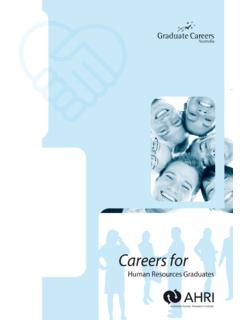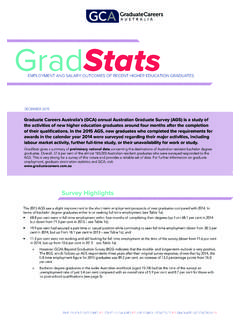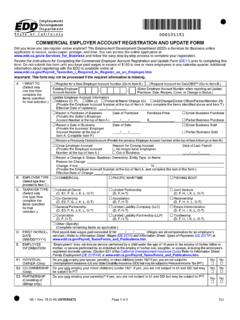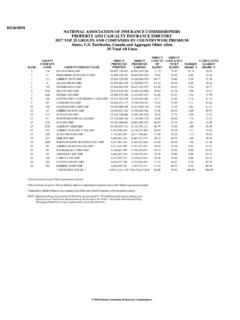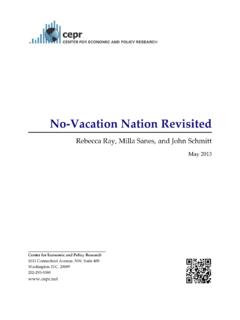Transcription of Graduate Outlook 2015 - Graduate Careers Australia
1 Graduate Outlook 2015 . The report of the 2015 Graduate Outlook Survey: Perspectives on Graduate Recruitment Acknowledgements Darren Matthews (Research Team Leader, Graduate Careers Australia ) was the principal author of this report . Bruce Guthrie edited the report and supplied additional content. Edwina Lindsay (Research Associate, Graduate Careers Australia ) was the project manager of the 2015 Graduate Outlook Survey and Dr Noel Edge was the project director. The authors and project director wish to acknowledge with gratitude the people involved in this research process. Thanks to the many Graduate employers and graduates who took the time to complete the 2015 Graduate Outlook Survey. If it were not for the effort of all of these individuals, these important data would not be available. Thank you all for your continued support. 2016 Graduate Careers Australia All rights reserved. No part of this publication may be copied or reproduced, stored in a retrieval system or transmitted in any form or by any means electronic, mechanical, photocopy, recording or otherwise without the prior written permission of the publishers.
2 Published by: Graduate Careers Australia Ltd (trading as Graduate Careers Australia ). PO Box 13222, Law Courts, Melbourne, VIC 8006. Level 9, 552 Lonsdale Street, Melbourne VIC 3000. Telephone: (03) 9605 3700. Facsimile: (03) 9670 5752. Email: Web: ISBN: 978-0-9871853-0-3. Contents 2. Graduate Recruitment .. 3. 2014 Recruitment Numbers .. 5. Graduate Skills 6. Recruitment of International Graduates .. 8. Graduate Recruitment Practices .. 10. Undergraduate and Employee Referral Programs .. 12. Graduate Recruitment and Preferred Institutions .. 13. Verbatim Responses .. 14. Graduate Recruitment Practices and Social Media .. 16. Verbatim Responses .. 18. Graduate 19. Key Selection Criteria .. 19. Least Desirable Graduate Characteristics .. 20. Employers' Ratings of Their 2014 Graduate Recruits .. 21. 2015 Graduate Recruitment .. 23. Graduate Employability Skills .. 24. Verbatim Responses .. 24. 2014 Graduate Intake.
3 27. Graduate Training .. 27. Graduate Salaries .. 27. Graduate Retention .. 28. Verbatim Responses .. 31. New Graduate Employees' Perspectives .. 34. Entering the Workforce .. 34. Application Process .. 36. Applications and Social Media .. 38. Job Satisfaction .. 39. Retention .. 40. References and Further Reading .. 42. Appendix A: The Survey Method .. 43. 1. Introduction Welcome to Graduate Outlook 2015 , Graduate Careers Australia 's (GCA) annual report on Graduate recruitment practices and trends in Australia . Now in its eleventh year, the Graduate Outlook Survey (GOS) examines the current perspectives of Graduate recruiters to present a focused and meaningful overview of the Graduate labour market. The GOS is undertaken to obtain an indication of the Outlook for Graduate recruitment in Australia and, in 2015 , was targeted at recruiters who hired graduates in 2014 to commence work in 2014-15. This year's report continues the examination of Graduate intake numbers, as well as recruiters'.
4 Perceptions of the calibre of their candidates, and their retention strategies. Current Graduate recruitment practices are examined in detail, including promotional techniques, recruitment through additional channels such as undergraduate programs and employee referrals, and the recruitment of international graduates. Some of these areas have been investigated every year since the inception of this series, allowing for the examination of Graduate recruitment trends over the last ten years. The report explores recruitment from particular institutions and Graduate training procedures, as well as the role of the Graduate 's social media profile and its influence in the recruitment decision- making process. Recruiters' comments are included to expand on related questions and are unedited except for minor modifications to aid comprehension. In the 2015 GOS, we added a survey of Graduate employees. Topics covered include application processes, retention, and their satisfaction with their Graduate position.
5 2. Graduate Recruitment The 2015 Graduate Outlook Survey gathered data from 638 Graduate employers from around Australia . Of these, 367 had employed graduates in 2014 for their 2014-15 intakes. This chapter will examine Graduate intakes by various company indicators. Table 1 shows that of the 638 Graduate employers that completed the survey in 2015 , per cent of them did not recruit any graduates in 2014. These employers were excluded from further analysis in this section. Table 1: Number of graduates recruited in 2014 (%, n). Number of graduates recruited 2014 Employers %. None 271 1-20 206 More than 20 62 No Answer 99 TOTAL 638 100. Table 2 shows that that the main group of recruiters of graduates in 2014 were from legal and professional services' ( per cent), with government, defence and health', construction, mining and engineering', and accounting and finance' also strongly represented. Table 2: Number of graduates recruited in 2014, by industry (%, n).
6 Industry 1-20 More No Total % Total n graduates than 20 Answer graduates Government, defence and health 67. Construction, mining and engineering 61. Accounting and finance 59. Legal and professional services 125. Manufacturing 15. Communications, technology and utilities 27. None of the above 13. TOTAL % 100 100 100 100. TOTAL N 206 62 99 367. Recruiters from legal and professional services' were most active in the marketplace with per cent of that group hiring between 1-20 graduates and a further per cent hiring more than 20. (see Table 2). Employers from government, defence and health ( per cent) and accounting and finance ( per cent) were also more likely to employ more than 20 graduates. Over 40 per cent of Graduate employers only had one formal intake period in 2014 ( per cent). while per cent of employers recruited as needed throughout the year, with no formal intake period (see Table 3). The manufacturing' and construction, mining and engineering' industries were most likely (over half of recruiters) to have just one formal intake, whereas recruiters from the legal and professional service' industry were the most likely to advertise as needed.
7 3. Table 3: Number of formal Graduate intake periods in 2014 by industry (%). As Industry 1 2 3+. needed Government, defence and health Construction, mining and engineering Accounting and finance Legal and professional services Manufacturing Communications, technology and utilities None of the above TOTAL Accounting and finance companies were most likely of all industries to have a formal Graduate program in place, although across all industries, more than half of all recruiters provided such a program (see Table 4). Smaller organisations were notably less likely to have a formal Graduate program in place, with per cent of companies with fewer than 20 employees offering such. Over eight-in-ten large companies (500 or more employees) were likely to have a program in place. Table 4: Organisations offering a formal Graduate program in 2014 (%). Industry Yes No Government, defence and health Construction, mining and engineering Accounting and finance Legal and professional services Manufacturing Communications, technology and utilities None of the above Size of organisation Yes No 1-19 employees 20-99 employees 100-499 employees 500 or more employees TOTAL 4.
8 2014 Recruitment Numbers Employers were asked to indicate the number of applications they got for their Graduate positions in 2014 including the number of positions available, applications received, applications which progressed to stage two of the hiring process, offers made and graduates actually employed Figure 1 charts the medians for these categories. Across all employers, the median number of applications received was 200 for every five positions. Only 20 of the 200 applications progressed to stage two, with five offers made and five accepted. 250. 200. 150. Number 100. 50. 0. Graduate positions Applications Applications Number of offers Graduates actually applied for received progressed to made employed stage 2. Figure 1: Median number of graduates at each stage of recruitment per employer, 2014 (n). 5. Graduate Skills Shortages Since 2005, participating recruiters have been asked to indicate whether they had difficulty sourcing/recruiting graduates from particular disciplines.
9 As shown in Figure 2, per cent of Graduate employers indicated that they did have trouble in the 2014 recruitment year ( 2015 survey and report ). This is up slightly from per cent in the 2014 survey (2013 recruitment year) and the third year in which this figure has increased, possibly suggesting an increase in competition and demand for graduates in some fields. 70. 60. 50. 40. % 30 20 10. 0. 2005 2006 2007 2008 2009 2010 2011 2012 2013 2014 2015 . Survey Year Figure 2: Proportion of employers who had difficulty sourcing graduates, 2005-15 surveys (%). 6. Employers who indicated that they had difficulties sourcing graduates were also asked to identify the particular disciplines that were of concern to them in 2014. The disciplines that recruiters had most difficulty sourcing were information technology ( percent), engineering ( per cent) and accounting ( per cent see Figure 3). Accounting Engineering Information Technology %.
10 Figure 3: Proportion of employers who had difficulty sourcing graduates, by discipline area, in 20141. When asked if they would have recruited more graduates if a greater number of appropriate candidates had been available; just over half of the employers ( per cent) agreed that they would have. 1. The three disciplines with the highest results only. 7. Recruitment of International Graduates Figure 4 presents a ten-year time series showing the percentage of employers indicating they had recruited international graduates in a given year. In the 2015 survey, per cent of employers indicated that they had recruited international graduates in 2014. This is an increase from the 2013 figures of per cent, and is a result comparable to the overall mean of per cent (represented by the straight line in Figure 4). % 2005 2006 2007 2008 2009 2010 2011 2012 2013 2014 2015 . Survey Year Figure 4: Proportion of employers who recruited international graduates with mean, 2005-15.


